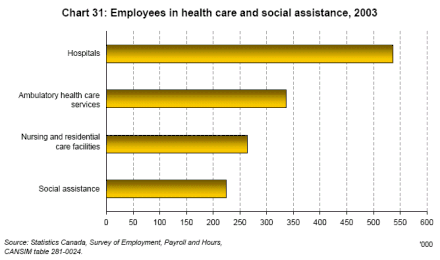

|
 |
Table of contents > Section E - Industry, class of worker and occupation >
Employees in health care and social assistance
Health care and social assistance employment continues to increase
- Hospitals account for 39% of the employees in health care and social assistance and continue to be the largest employer in this sector. Throughout the 1990s, employment in hospitals declined each year. In 2000, employment in this sub-sector changed direction and grew in each subsequent year. Although there was a 2.3% increase in 2003 to 537,000 employees, this still left employment 6.3% lower than in 1991.
- Ambulatory health care services, which includes services such as those offered in the offices of physicians, dentists and other health practitioners, remains the second largest employer in health care and social assistance. In 2003, ambulatory health care services accounted for one of every four health care and social assistance employees, up from one of every five in 1991.
- The employment levels in both nursing and residential care facilities and social assistance increased by 4.1% from 2002 to 2003. Although social assistance remains the smallest component, it has shown the largest increase since 1991, with an additional 97,000 employees (a 77% increase). Those in individual and family services made up almost half of social assistance workers in 2003. Child day-care services, vocational rehabilitation services, community food and housing, and emergency and other relief services are also included in the social assistance sub-sector.
Enlarge chart
|


